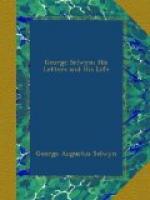(248) Captain John Willett Payne, known as “Jack Payne,” was secretary to the Prince of Wales.
(249) The Marquis of Lothian (1737-1815) belonged to the “fast set.” He commanded the first regiment of Life Guards, and was a favourite of George iii., whom he deserted at the division caused by his first attack of insanity; at the King’s recovery he was transferred to another regiment.
(250) T. Townsend.
(251) Frederick, Duke of York.
(252) Mrs. Fitzherbert (1756-1837). It was the occasion of much curiosity during her life and after if she were legally the wife of the Prince of Wales, afterwards George iv. The marriage took place in her own house, her brother and uncle being present; a clergyman of the Church of England performed the ceremony. But by the Marriage Act of 1772 a marriage by a member of the Royal Family under twenty-five, without the King’s consent, was invalid, and by the Act of Settlement a marriage by the heir-apparent to a Roman Catholic was also invalid. In 1787 the Prince, in order to obtain money from Parliament, without doubt gave Fox authority to deny the marriage in the House of Commons, though he pretended great indignation toward Fox to Mrs. Fitzherbert. On the Prince’s marriage to the Princess Caroline, Mrs. Fitzherbert ceased for a time to live with him, but acting on the advice of her confessor, returned to him, and gave a breakfast to announce it to the fashionable world, where she was a favourite. About 1803 she broke off all connection with the Prince, retiring from the Court with an annuity of 6,000 pounds. George iv. wore her portrait until his death; her good influence over him was recognised by George iii. and the Royal Family, who always treated her with consideration.
(253) The examination on oath of the five physicians in attendance on the King took place by direction of Pitt on December 3rd, the day before the meeting of Parliament. Fifty-four members were present.
(254) The Lord Gower of the preceding correspondence.
Between the following and the preceding letter events had moved rapidly in France. The National Assembly had been formed to be changed into the Constituent Assembly, the tricolour had sprung into existence, and the Bastille fallen. The Declaration of the Rights of Man had been promulgated. But Selwyn’s information upon the state of France was not very accurate.
(1788, Dec. 5?)—Postscript. Good God, Lady C., what have I done? Mie Mie wrote a letter yesterday to her mother; I was to put it in the same envelope with’ my own. They were only to thank her for hers, which the Comte d’Elci(255) brought me from her, enquiring after Mie Mie’s health. To-day I find Mie Mie’s letter on my table. I shall send it by the next post, but I am afraid that I put into my envelope a sheet which was intended for Lord Carlisle. Pray ask him if he had two sheets, or what he had. I am in hopes that, par distraction, it was only a sheet of blank paper. Yet that I did not intend neither; she shall have no carte blanche from me. I am miserable about this. What makes me hope that it was not part of my rhapsody to Lord C. is, that generally my sheets to him are barbouilled on all the sides, and I know there was nothing of that. Tirez-moi de mon incertitude, si vous le pouvez,




